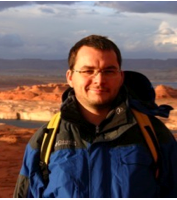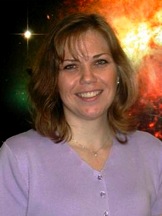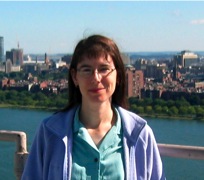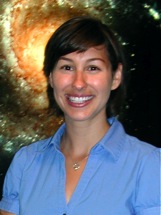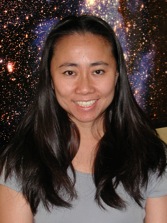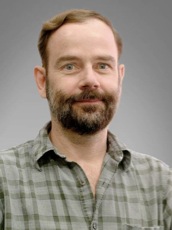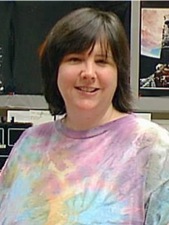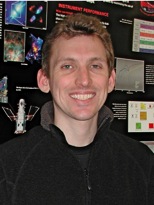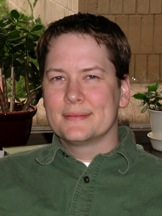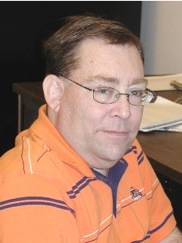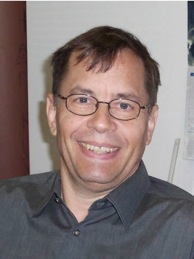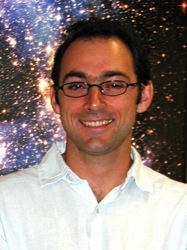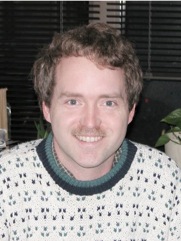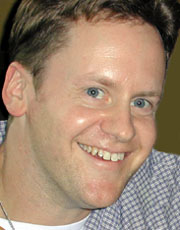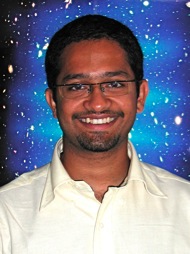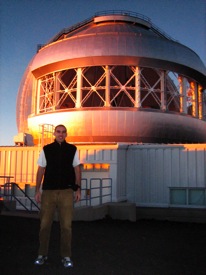Daniel Apai
Daniel Apai's research focuses on the formation and properties of planetary systems. He is using ground- and space-based telescopes to study planet-forming disks around stars of different masses and high-contrast techniques to directly image giant planets around stars closest to the Sun. His recent results include a Spitzer Space Telescope study of disks around brown dwarfs that demonstrated that the first steps of planet formation also occur around these very low mass, faint objects. Motivated to develop a consistent picture on the formation of the solar system and planetary systems around other stars he is co-editing a book on planet formation with meteorite-expert Dante Lauretta. The book will appear in the Cambridge University Press' Planetary
Science Series in Fall 2009 under the title "Protoplanetary Dust: The Astrochemical and Cosmochemical Perspectives".
email — apai
——————————————————————
Elizabeth Barker
Interested in studying small Solar System bodies, including comets, asteroids, and KBOs.
email — ebarker
——————————————————————
Susan Benecchi
My work focuses on Kuiper belt binaries. As part of my graduate work I was part of a research team (The Deep Ecliptic Survey; DES) that discovered, cataloged and followed up on Kuiper Belt objects for the purposes of dynamical and physical studies. My current work seeks to understand binaries in this population in more detail. My observations focus on understanding their photometric and orbital properties. I am also very interested in science education at the middle-high school and college levels. I have taught various observational astronomy classes in the past and am currently involved with Project ASTRO in the Baltimore schools.
Website — http://alum.mit.edu/www/susank
email — susank
——————————————————————
Marty Bitner
I am interested in the structure and evolution of protoplanetary disks. My recently completed Ph.D. studies focused on the gas content of disks. I carried out a survey for molecular hydrogen emission from disks using the TEXES high resolution mid-infrared spectrometer. Results of this study will be published in ApJ in December. The astro-ph article can be found here: http://arxiv.org/abs/0808.1099. At STScI, I am currently working
with Spitzer Space Telescope observations along with ground-based optical spectroscopy to study the evolution of disks in the 5-20 Myr Sco-Cen OB association.
email — mbitner
——————————————————————
Tiffany Borders
I am a new RIA hire (at the moment I don't know which instrument I'll be working with). My research for my master's thesis was on the search for transiting extrasolar planets in the open cluster M52.
email — borders
——————————————————————
Robert Brown
I am studying mutually consistent requirements for astrometry to discover Earth like planets, and follow-up coronagraphy to characterize them. The goal is to understand the necessary scale of a future optical telescope in space. It seems likely that 16-m class missions will be required. Also, I have a particular interest in the science operational aspects of exoplanetary study, which are discussed in this paper:
email — rbrown
——————————————————————
Christine Chen
Website — http://www.stsci.edu/~cchen
email — cchen
——————————————————————
Carol Christian
I am interested in astrobiology, but primarily do IT, visualization for education and outreach work.
Website — http://www.stsci.edu/~carolc
email — carolc
——————————————————————
Timothy Dolch
I study the extragalactic background light in the optical and infrared, as well as the foreground zodiacal light from the interplanetary dust cloud. My research interests center around constraining these measurements, using archival HST data, galaxy surveys, and data from planetary spacecraft.
email — tdolch1
——————————————————————
Ron Gilliland
Gilliland is a Co-I on the Kepler Mission to detect analogues of the Earth via transit signals to be found from ultra-precise monitoring of 100,000 stars for 3.5 yr. He has been involved with several HST observing programs aimed at detection of, and especially follow up studies on extrasolar planetary systems. With the Kepler launch only a few months away he will be concentrating on helping obtain the best technical and scientific results from this mission.
email — gillil
——————————————————————
Sherie Holfeltz
I am currently 100% functional, working on the JWST FGSs, but I am interested in our Solar System, planets, and life/astrobiology. In the (far distant) past, I've worked on TPF target lists and asteroid projects.
email — holfeltz
——————————————————————
Ian Jordan
My area of research is astronomical instrumentation, operations, and astronautics; focusing mostly on extrasolar planet-study techniques over the past decade. I participated in the UMBRAS group which examined primitive external occulter concepts. I designed an optically scaled external occulter demonstration, led a group that implemented it (WASI-UMBRAS), processed data obtained therefrom, and presented it. I have built code for a space astronomy mission simulator. My publication participation history can be examined from a combined search of my STScI homepage and the UMBRAS website publications page ( http://umbras.org ).
Website — http://www.stsci.edu/~jordan
email — jordan
——————————————————————
Mario Livio
Recent paper: Villaver & Livio, 2007, ApJ, 661, 1192.
email — mlivio
——————————————————————
Douglas Long
I work with Peter McCullough on the XO project to discover and characterize transiting extrasolar planets.
Website — http://www-int.stsci.edu/~pmcc/xo/
(a bit out of date)
email — dlong
——————————————————————
Russ Makidon
My work involves developing instrument concepts and data analysis techniques to enable the direct detection and study of extrasolar planets.
email — makidon
——————————————————————
Matt McMaster
I am a Senior Research and Instrument Analyst currently working in the AWT (ACS/WFPC2 Team) but have always had an interest in the solar system and extra-solar planets. I work almost exclusively on WFPC2 projects and have worked on (both currently and in the past): generation of bias and dark reference files, Linear Ramp Filters, Polarizers, bias jumps, WF4 anomaly, WF4 destreaking code, WFPC2 Data Handbook, WFPC2 Instrument Handbook, examining WFPC2 images for anomalies (I've found ~50 asteroids/comets while doing this, some known, most not), WFPC2 Web Curator, WFPC2 Shutter Anomaly, and a lot of other projects I can't recall. On the science side, I worked on projects involving F and G dwarf stars, HIPPARCOS stars, radio mapping of galactic jets, interacting galaxies, and testing the correlation between physical parameters and galaxy types using radio profiles.
email — mcmaster
——————————————————————
Max Mutchler
I have been primarily working on Hubble observations of small solar system objects: dwarf planets Pluto and Ceres, large asteroids Vesta and Pallas, comets Tempel 1, Schwassmann-Wachmann 3, Holmes. I have also worked on observations of Jupiter, Mars, and the Moon (yes, THE Moon). Some of these
observations have been in support of other NASA missions
(Deep Impact, New Horizons, Dawn). Observations of small moving targets often require complex observing strategies and data analysis methods, such as dither/drizzle and deconvolutions, to extract as much information as possible from the data.
References:
http://arxiv.org/abs/astro-ph/0601018 (Pluto's moons Nix and Hydra)
http://arxiv.org/abs/astro-ph/0605014 (Colors of Nix and Hydra)
http://adsabs.harvard.edu/abs/2008LPI....39.2253L (Vesta mapping)
Website — http://www.stsci.edu/~mutchler/
email — mutchler
——————————————————————
Abhijith Rajan
I joined STScI as a Research and Instrument Analyst on Sep 15 2008.
Prior to joining the Institute, I was at San Diego State University where I complete my MS in Astronomy.
I have been part of three research projects -
1. Transit timing variation study of the exoplant HD 209458b
2. Analyzing and implementing improved CCD photometry techniques for characterizing exoplanets
3. Calculating the system parameters of the long period, high eccentricity exoplanet HD 17156b (Irwin et al. 2008)
email — arajan
——————————————————————
David Soderblom
Observational studies of the evolution of solar-type stars and their age-related phenomena:
Angular momentum evolution, from formation through their main sequence lives.
Lithium depletion and its relation to convection.
Chromospheric activity and the rotation-activity relation.
Application of age-related phenomena to Galactic problems, such as determining the ages of low-mass stars, and studying “disk heating,” stellar kinematics, and the Galaxy’s star formation history.
Comparative studies of the Sun to other stars:
Implications for the formation and evolution of the Sun.
The angular momentum history of the Sun.
Application of knowledge of solar-type stars to the Search for Extraterrestrial Intelligence and planets beyond our Solar System.
Solar-type stars as a population.
email — drs
——————————————————————
Remi Soummer
My research interests focus on the detection and characterization of exoplanets using direct imaging and coronagraphy from ground and space (JWST). I work on the development of new instrumentation for high-contrast projects, and on ground-based observations with Adaptive Optics (coronagraphy, polarimetry and integral field spectroscopy). Currently, I am the coronagraph architect for the Gemini Planet Imager (http://gpi.berkeley.edu) which will be on sky in 2011 and will aim at the detection and characterization of young giant planets and disks.
email — rsoummer
——————————————————————
Jeff Valenti
I model spectra of planet hosts discovered in radial velocity or transit surveys (e.g., Valenti & Fischer 2005; XO papers). Debra Fischer and I quantified the relationship between stellar metallicity and detected planets (Fischer & Valenti 2005). I am working with Geoff Marcy and Debra Fischer to improve radial velocity detection algorithms, and I am working with Peter McCullough to characterize the stellar hosts of transiting planets discovered by the XO survey. I have studied the feasibility of exoplanet characterization via transit spectroscopy.
email — valenti
——————————————————————
Rick White
I am part of an ACS GTO science team project that attempts to directly image planets around nearby stars using the ACS coronagraph and the "spectral deconvolution" technique. I'm interested in applications of image/data processing techniques for high contrast imaging.
Website — http://sundog.stsci.edu/rick
email — rlw
Meet people in this research group
members can be contacted through their email [at] stsci [dot] edu
